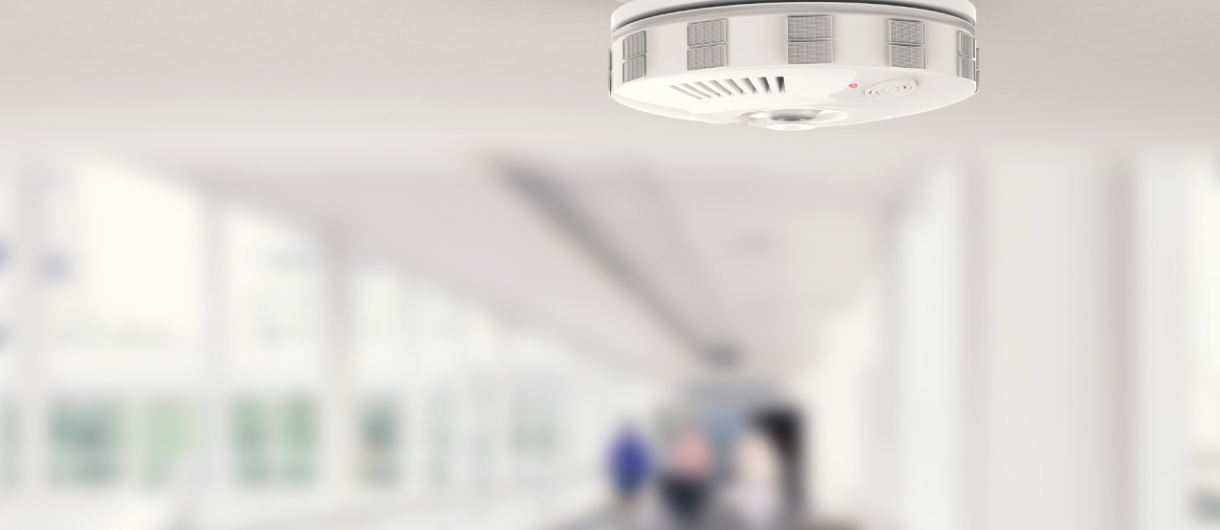
Smoke detectors: types, regulations and their role with smoke curtains
Within any installation, fire detection systems are essential components. Thanks to them, it is possible to act quickly and efficiently, taking the necessary measures to protect the facilities, the people who work there and the stored goods.
Currently, there are various types of detection systems (such as heat, gas or flame detectors). But in this article, we want to talk especially about smoke detectors: systems whose presence is becoming essential in any installation.
What types of smoke detectors can we find on the market today?
Smoke detection systems are high-quality equipment, whose objective is to monitor your protection area in order to automatically detect the presence of smoke in the air, emitting an acoustic and/or visual signal that warns of the danger of fire. It is a fundamental element today for the protection of any installation, being one of the earliest ways of identifying a fire in its initial phase.
Thanks to advances in technology, smoke detectors have evolved over time and currently, there are two systems that are sensitive to particles derived from combustion and/or pyrolysis:
Ionic smoke detectors
These smoke detection systems are focused on detecting very small particles, practically invisible to the naked eye. But how do they work? By a principle of ionization of the air.
Ionic smoke detectors are made up of two plates and a radioactive material that ionizes the air that passes between them. As a result, a very small electric current circulates in this space. As soon as small particles of smoke enter, the ionization is reduced, reducing or interrupting the current and activating the alarm.
Due to its sensitivity and speed, it is mostly recommended for the chemical industry where fire can spread quickly and rapidly due to stored materials.
Optical smoke detectors
Also known as photoelectric detectors, they are devices capable of detecting smoke produced by slow or low-intensity combustion.
They consist of a light emitter and a photosensitive receptor. And its operation is based on the emission of a light that falls continuously on the photoelectric cell. When smoke appears, the light disperses and an audible alarm is automatically generated warning of the fire.
These systems are usually placed above all in air extraction ducts (ventilation) to detect the presence of smoke in large rooms and are usually used, above all, in shopping malls, supermarkets, or warehouses, among others.
What regulations do we have to consider when talking about smoke detectors?
All detection systems must comply with a series of regulations. In fact, fire detection must comply with the Basic Fire Safety Document of the Technical Building Code (for spaces that are not for industrial use) and the Fire Safety Regulations in Industrial Establishments (for buildings for industrial use).
In addition, we must take into account two other outstanding standards such as UNE EN 54 (fire detection and alarm systems) or UNE 23007-14 (fire detection and alarm systems. Part 14: Planning, design, installation, commissioning service, use and maintenance).
And with all this in mind, it is important to answer one last question:
What benefits can these detection systems provide?
Whatever the chosen model, smoke detectors are essential in any industrial and logistics warehouse, but not only to sound the alarm to the personnel working in those facilities. They are also essential for the activation of other fire protection systems, such as extinguishing systems, smoke extraction systems or even sectorization systems.
Along with smoke detectors, the work of smoke control curtains (textile screens designed to channel and contain the smoke generated in the event of a fire) is especially relevant. The close collaboration between the detectors and these barriers undoubtedly helps….
- Sound the alarm in the initial phase of any fire and prevent the spread of smoke (thus avoiding further damage to facilities and loss of property).
- Avoid the effect of gases and toxic particles among colleagues who work near the source of the fire, reducing the number of intoxications due to smoke inhalation and helping with evacuation tasks.
- Assist in firefighting (allowing firefighters early access to the affected area and improving their visibility).
- And, of course, reduce costs (early detection and sectorization help to centralize damage in a single point).
Any installation can benefit from the use of these two systems together. But before deciding which detectors and barriers are the best for a specific project, a detailed study of the characteristics of each space and the risks that exist in each one is essential to design the most appropriate strategy for each case and choose the most convenient models.